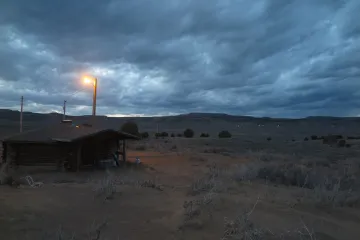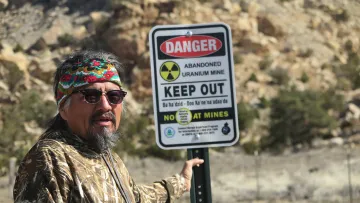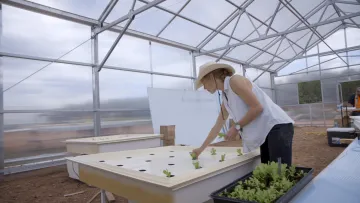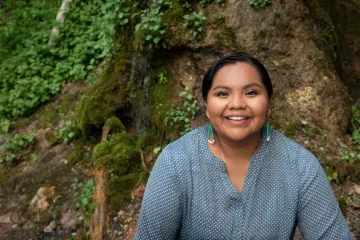On Navajo Nation, Taking Clean Water Off the Grid
A group of faculty, staff and students sets out to build an off-the-grid system to power water filtration for communities across the Navajo Nation, where running water is not universal. But first, they set out to understand life on the reservation.

With an area the size of West Virginia, the Navajo Nation is the largest reservation in the United States, but some areas have never been connected to central power and water due to rugged terrain and low population density. Today, the Navajo Nation estimates that of its 357,000 residents, up to 35% don’t have running water in the home.
Photo by Mari Cleven/RDI
It was 31 degrees Fahrenheit in Blue Gap, Arizona, a community on the Navajo Nation with eight people per square mile. Earl Tulley sat cross-legged on the floor of a hoghaan, a traditional Navajo home. Across from him, a group of graduate students from the University of Arizona sat on sheepskin rugs, their faces lit by the warm glow of a kerosene lamp—a Tulley family heirloom. It was quiet, except for the crackle of a wood-burning stove.
Tulley, in a red velvet tunic, paisley headscarf, and horn-rimmed eyeglasses, was about to share traditional Diné (Navajo) teachings, like the concept of hozhó, or harmony, that would guide the students in the weeks to come.
The students are the first cohort of University of Arizona graduate students in a program designed to teach them how to develop food, energy and water-related technologies that truly reflect the culture and lifestyle of the Diné.
The program, Indigenous Food, Energy and Water Security and Sovereignty, or Indige-FEWSS, is funded by a five-year, $3 million grant from the National Science Foundation. Led by Karletta Chief, a UA associate professor of environmental science, Indige-FEWSS is an unprecedented collaboration between the UA and Diné College to teach the next generation of STEM professionals not only how to confront food, energy, and water insecurity among Indigenous communities, but how to do so while letting tradition guide their work.
“We want to enable these trainees to tackle critical, real-world food, energy, and water problems with an understanding of culture and sovereignty of Indigenous people,” Chief said.
Sitting in the hoghaan, these students—including Earl Tulley’s daughter, Nikki Tulley, a PhD student in environmental science—listened carefully to his orations of Diné values, contemplating how technology they create might reflect them. Here, immersing themselves in Diné history, culture and knowledge, their work began.

The traditional hoghaan where Indige-FEWSS students stayed overnight and heard oral histories of the Diné people
Photo by Torran Anderson/Institute for Energy Solutions
Unregulated Water: A Public Health Risk on Navajo Nation
With an area the size of West Virginia, the Navajo Nation is the largest reservation in the United States, but some areas have never been connected to central power and water due to rugged terrain and low population density. Today, the Navajo Nation estimates that of its 357,000 residents, up to 35% don’t have running water in the home.
Those without regularly drive long distances to haul water for drinking, cooking and bathing. This water comes often from unregulated sources, like livestock wells and springs. Across the Navajo Nation, the number of unregulated water sources is estimated to be in the low thousands. Their safety and cleanliness is unknown.
Christopher Yazzie, a graduate student in the Indige-FEWSS program, was raised on the reservation, in Tuba City. His in-laws live on the reservation still, hauling water from an unregulated well every week.
Yazzie’s wife and sister-in-law drove the graduate students to the well. They were surprised and relieved to find there was not a long line of cars in front of them. There usually is. They suspected the day’s bone-chilling wind kept people inside. The students took turns filling five-gallon buckets with well water and putting them in the back of the family’s pickup truck.
Yazzie’s in-laws don’t know who dug the well or what’s in the water. They know only that they have been using this well for decades.

Graduate students in the Indige-FEWSS program fill buckets with well water and load them onto a pickup truck for use by a Diné family.
Photo by Torran Anderson/Institute for Energy Solutions
The Navajo Nation Environmental Protection Agency policy prohibits human consumption of water from unregulated sources because they’re not regulated in accordance with the Safe Drinking Water Act. Yet human consumption remains widespread due to the lack of public water systems.
Across the Navajo Nation, unregulated water sources often exceed drinking water standards for chemicals like arsenic and uranium, an impact of earlier mining activities. According to the U.S. Environmental Protection Agency, the use of unregulated water sources is the greatest public health risk associated with drinking water for the Navajo Nation. A study published in 2018 by the Navajo Department of Health reported that compared to the non-Hispanic white population in Arizona, Navajos have a higher incidence and mortality of liver, kidney, stomach and gallbladder cancers.
Meanwhile, the Indian Health Service reported that it would cost $200 million to provide access to safe drinking water in all Navajo homes.
The Indige-FEWSS Water Filtration System Comes to Navajo Nation
Without access to such funds, the 12 Indige-FEWSS graduate students—half of whom are Native American—and undergraduate students from Diné College set their sights on a budget-friendly, mobile, solar-powered water purification system instead.
“Tó éí ííńá át'é,” said Benita Litson, director of Diné College’s Land Grant Office. It’s Diné for “Water is life,” a common phrase on the reservation. “And purification makes it safe and clean.”
Letting traditional Diné culture and ecological knowledge guide the process, the students designed a system with the capacity to provide 50 gallons of safe, clean water to 30 Navajo families per day.
Their $25,000 solar-powered water filtration system largely comprises materials available at a hardware store, including, for example, two 275-gallon caged tote tanks, a few water filters, and some PVC pipes. The students then placed the system on a flatbed trailer. The system design reflects lifestyles and culture on the reservation: it’s mobile for hauling and can be built with readily available products.

A Diné College student demonstrates use of the water filtration system.
Photo by Torran Anderson/Institute for Energy Solutions
“We [Diné] are a problem-solving people, and we are a resilient people,” Nikki Tulley said. “And this resiliency is a greater benefit to us when entering the world of western science.”
The solar-powered system can purify up to 1,500 gallons of water per day, removing nearly 100% of dissolved chemicals, including arsenic and uranium--well below the concentrations to meet drinking water standards--without the need for connection to centralized water or power.

Earl Tulley takes the Indige-FEWSS students to a one-time uranium mine.
Photo by Torran Anderson/Institute for Energy Solutions
Using the system, communities on the reservation can continue to haul water from wells but can ensure its safety and cleanliness.
“Trainees in the Indige-FEWSS program are not doing research to be put on the shelf, but we’re doing research to have real impact and solve real problems that our community has,” said Chief, who grew up on the Navajo Nation.
A Starting Point
The Indige-FEWSS program is only a first step toward addressing food, energy and water insecurity among Indigenous communities. It trains students for careers dedicated to this work—the next generation of problem-solvers, who will think holistically about the communities they serve.
“Our vision at the University of Arizona is to develop a diverse workforce with intercultural awareness and expertise in sustainable food, energy, and water systems,” said Chief.

At Diné College, Indige-FEWSS graduate student Bekah Waller teaches undergraduate students about sustainable food production.
Photo by Mari Cleven/RDI
Other UA faculty involved in the program include Robert Arnold, professor emeritus of chemical and environmental engineering; Benedict Colombi, professor of American Indian studies; Murat Kacira, professor of biosystems engineering; Kimberly Ogden, professor of chemical and environmental engineering; Erin Ratcliff, assistant professor of materials science and engineering; Kelly Simmons-Potter, professor of electrical and computer engineering; and Valerie Shirley, assistant professor of teaching/learning and sociocultural studies.
Under their advisement, each UA student in the program will receive a graduate degree in a STEM field such as electrical engineering or materials science while also receiving a minor in Indige-FEWSS.
The program also provides cutting-edge teaching tools to Diné College—including the water filtration system, which is now being used on the campus to educate and train its undergraduate students in STEM fields.

Nikki Tulley
Photo by Mari Cleven/RDI
Following graduation, both Nikki Tulley and Christopher Yazzie intend to create businesses that address their community’s need for clean, safe water. Yazzie is considering a business focused on miniature versions of the filtration system, built for less money, for single-family use.
“Through Indige-FEWSS, I’m able to fulfill a promise I made to my family as a young girl, saying that I’ll never forget where I come from and I’ll never think that I am better than anybody, but instead be grounded and remember my place in the universe,” Tulley said. “My place in the universe will always be bringing resources and services to the Navajo Nation.”

